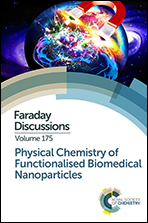A Combined 7Li NMR, Density Functional Theory and Operando Synchrotron X-Ray Powder Diffraction to Investigate a Structural Evolution of Cathode Material LiFeV2O7
IF 3.3
3区 化学
Q2 CHEMISTRY, PHYSICAL
引用次数: 0
Abstract
In our recent study, we demonstrated using 7Li solid-state Nuclear Magnetic Resonance (ssNMR) and single-crystal X-ray diffraction, that the cathode LiFeV2O7 possesses a defect associated with the positioning of vanadium atoms. We proposed that this defect could be the source of extra signals detected in the 7Li NMR spectra. In this context, we now apply density functional theory (DFT) calculations to assign the experimental signals observed in 7Li NMR spectra of the pristine sample. The calculation results are in strong agreement with the experimental observations. DFT calculations are a useful tool to interpret the observed paramagnetic shifts and understand how the presence of disorder affects the spectra behavior through the spin-density transfer processes. Furthermore, we conducted a detailed study of the lithiated phase combining operando synchrotron powder X-ray diffraction (SPXRD) and DFT calculations. A noticeable volume expansion is observed through the first discharge cycle which likely contributes to the enhanced lithium dynamics in the bulk material, as supported by previously published ssNMR data. DFT calculations are used to model the lithiated phase and demonstrate that both iron and vanadium participate in the redox process. The unusual electronic structure of the V4+ -exhibits a single electron on the 3dxy orbital perpendicular to the V-O-Li bond being a source of a negative Fermi contact shift observed in the 7Li NMR of the lithiated phase.结合 7Li NMR、密度泛函理论和 Operando 同步 X 射线粉末衍射研究阴极材料 LiFeV2O7 的结构演化
在最近的研究中,我们利用 7Li 固态核磁共振(ssNMR)和单晶 X 射线衍射证明,阴极 LiFeV2O7 存在与钒原子定位相关的缺陷。我们提出,这一缺陷可能是 7Li NMR 光谱中检测到的额外信号的来源。在这种情况下,我们现在应用密度泛函理论(DFT)计算来分配在原始样品的 7Li NMR 光谱中观察到的实验信号。计算结果与实验观察结果非常吻合。DFT 计算是一种有用的工具,可用于解释观察到的顺磁性偏移,并了解无序的存在如何通过自旋密度转移过程影响光谱行为。此外,我们还结合操作同步辐射粉末 X 射线衍射 (SPXRD) 和 DFT 计算对石化相进行了详细研究。在第一个放电周期中,我们观察到了明显的体积膨胀,这很可能是块体材料中锂动力学增强的原因,之前公布的 ssNMR 数据也证明了这一点。DFT 计算用于建立锂化相模型,并证明铁和钒都参与了氧化还原过程。V4+ 不寻常的电子结构在垂直于 V-O-Li 键的 3dxy 轨道上显示出一个电子,这是在锂化相的 7Li NMR 中观察到的负费米接触位移的来源。
本文章由计算机程序翻译,如有差异,请以英文原文为准。
求助全文
约1分钟内获得全文
求助全文
来源期刊

Faraday Discussions
化学-物理化学
自引率
0.00%
发文量
259
期刊介绍:
Discussion summary and research papers from discussion meetings that focus on rapidly developing areas of physical chemistry and its interfaces
 求助内容:
求助内容: 应助结果提醒方式:
应助结果提醒方式:


